Aircraft
1/32 Scale Hasegawa Model
Focke-Wulf Fw 190 D-9 Dora “Red 13”
Pilot & Markings
Oberleutnant Klaus Faber — JV44 Würger-Staffel, Ainring Germany, May 1944
Scale & Kit
1/32 Hasegawa Model Kit
History
Although the Me 262 was famed for being the world’s first operational turbojet airplane, the great runway length it required and slow acceleration made it vulnerable during takeoff and landing. A weakness that was well known to allied pilots.
Thus, the Platzschutzstaffel (airfield protection squadron) was established by General Adolf Galland to serve as fighter cover for Me 262 airfields. The JV44 aerial defence unit, known as “Würger-Staffel” (butcher bird), was comprised of the long nosed “Dora” Focke-Wulf Fw 190. These high-speed, high-altitude interceptors were painted bright red on their underbelly with white stripes to help anti-aircraft batteries distinguish them from allied aircraft. The paint scheme was a request by the pilots themselves, perhaps as a result of the failed operation Bodenplatte, where a number of German aircraft were lost to friendly fire.
Considered by many to be the pinnacle of German piston engine aircraft, the Fw 190 D-9 “Dora” proved to be more than a match for allied Mustangs and Spitfires. The final victory of the JV44 is said to be scored by Oberleutnant Klaus Faber while flying the “Red 13” represented in this airplane model kit. He claimed a P-47 Thunderbolt while on a flight to pick up some whiskey. Although Faber’s victory totals are unknown, it’s most certain that he was an “Experten”.
Hasegawa’s 1/32 airplane model kit was used to replicate Faber’s “Red 13” (W.Nr. 213240). Additional aftermarket parts were also used to reproduce the exact features of his Fw 190 D-9 “Dora”. The Eagle Editions super detailed resin cockpit, corrected 5 piece gun cowling, radiator cowling, main tires, tail wheel and yoke were installed for historic accuracy. As a customized addition, four wires were installed (two on each side) behind the headrest in the canopy. These are accurate to photo references of the original airplane. The inscription on the portside reads: “Rein muß er und wenn wir beide weinen!” (In he goes and then we both cry!). Enjoy the photos of Klaus Faber’s “Red 13”.

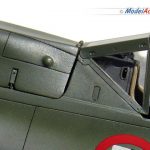



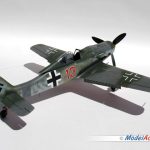


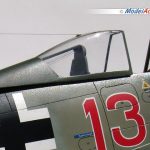
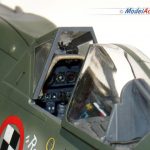







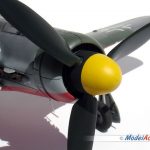


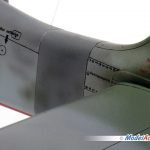
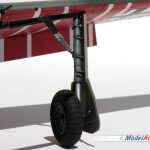








Leave a Reply